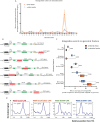Genome-wide profiling of retroviral DNA integration and its effect on clinical pre-infusion CAR T-cell products
- PMID: 36348415
- PMCID: PMC9644589
- DOI: 10.1186/s12967-022-03729-5
Genome-wide profiling of retroviral DNA integration and its effect on clinical pre-infusion CAR T-cell products
Abstract
Background: Clinical CAR T-cell therapy using integrating vector systems represents a promising approach for the treatment of hematological malignancies. Lentiviral and γ-retroviral vectors are the most commonly used vectors in the manufacturing process. However, the integration pattern of these viral vectors and subsequent effect on CAR T-cell products is still unclear.
Methods: We used a modified viral integration sites analysis (VISA) pipeline to evaluate viral integration events around the whole genome in pre-infusion CAR T-cell products. We compared the differences of integration pattern between lentiviral and γ-retroviral products. We also explored whether the integration sites correlated with clinical outcomes.
Results: We found that γ-retroviral vectors were more likely to insert than lentiviral vectors into promoter, untranslated, and exon regions, while lentiviral vector integration sites were more likely to occur in intron and intergenic regions. Some integration events affected gene expression at the transcriptional and post-transcriptional level. Moreover, γ-retroviral vectors showed a stronger impact on the host transcriptome. Analysis of individuals with different clinical outcomes revealed genes with differential enrichment of integration events. These genes may affect biological functions by interrupting amino acid sequences and generating abnormal proteins, instead of by affecting mRNA expression. These results suggest that vector integration is associated with CAR T-cell efficacy and clinical responses.
Conclusion: We found differences in integration patterns, insertion hotspots and effects on gene expression vary between lentiviral and γ-retroviral vectors used in CAR T-cell products and established a foundation upon which we can conduct further analyses.
© 2022. The Author(s).
Conflict of interest statement
The authors declare no competing interests.
Figures







References
-
- Lee DW, Kochenderfer JN, Stetler-Stevenson M, Cui YK, Delbrook C, Feldman SA, Fry TJ, Orentas R, Sabatino M, Shah NN, et al. T cells expressing CD19 chimeric antigen receptors for acute lymphoblastic leukaemia in children and young adults: a phase 1 dose-escalation trial. Lancet. 2015;385:517–28. - PMC - PubMed
-
- Shah NN, Highfill SL, Shalabi H, Yates B, Jin J, Wolters PL, Ombrello A, Steinberg SM, Martin S, Delbrook C, et al. CD4/CD8 T-cell selection affects chimeric antigen receptor (CAR) T-cell potency and toxicity: updated results from a phase i anti-CD22 CAR T-Cell Trial. J Clin Oncol. 2020;38:1938–50. - PMC - PubMed
Publication types
MeSH terms
Substances
Grants and funding
LinkOut - more resources
Full Text Sources
Miscellaneous

